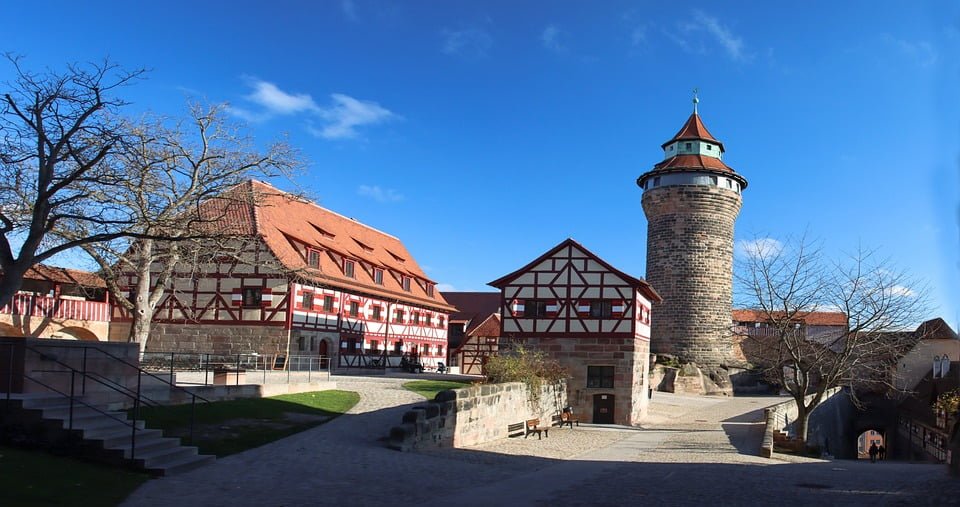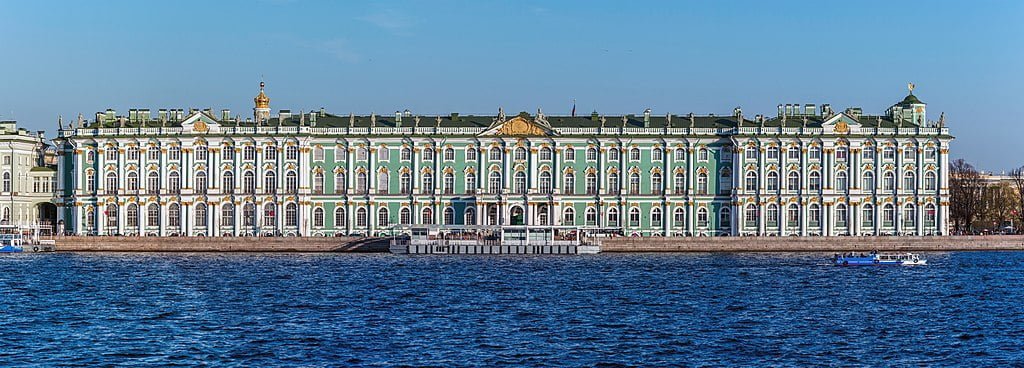The beautiful construction that is this medieval castle has been around for more than a thousand years and has been historically regarded as one of the most powerful walled castles throughout Europe. The walls of the castle are also amongst the strongest ones.
It is not difficult to imagine what Nuremberg Castle would have been like during the times of conflict and conquest when it served as a stronghold and was regarded as one of the most significant structures in the Holy Roman Empire. It stood firm through the Thirty Years’ War (1618 to 1648), demonstrating its tough built.
This article is equipped with all the information required to get to know Nuremberg Castle, including a history, compelling facts, and a travel guide. Let’s explore it together and discover the splendor of the Holy Roman Empire … and get you well on your way to planning a visit to this illustrious castle.
Table of Contents
The double chapel was built with a unique feature: the emperor’s gallery. It kept the emperor from keeping his distance from the court.

Frequently Asked Questions
Where is Nuremberg Castle Located?
Nuremberg Castle is situated in the ancient city of Nuremberg, in the state of Bavaria, midway between Munich and Frankfurt in Germany.
When was Nuremberg Castle Built? Who Build It?
The castle was originally constructed in 1027 by the Salian Kings of the Holy Roman Emperors.
When is The Best Time to Visit the Castle?
Nuremberg Castle is open to the public all year. If touring the garden is on your bucket list as well, you must stop by the park in April to October as the garden only allows visitors between those months.
What Other Monuments are Located Nearby?
To enhance the experience, it would be best to visit some other magnificent landmarks in Nuremberg when you visit Nuremberg Castle. These landmarks include: St. Lorenz Church, Nazi Party Rallyground, Nuremberg Palace of Justice, and the Germanisches National Museum.
FOR HISTORY | BEAUTIFUL IMAGES | INTERESTING FACTS | TRAVEL TIPS
Early History
The castle–which consists of a collection of medieval fortified structures on a sandstone ring in the middle of Nuremberg’s historic district–is regarded as one of Europe’s most formidable medieval fortifications. It represents the dominant significance of the Holy Roman Empire and the special function of the Imperial City of Nuremberg.
German rulers in the Middle Ages did not have a capital; instead, they traveled from one castle to the next under the title of Holy Roman Emperor after being crowned by the Pope. As a result, the castle in Nuremberg rose to prominence as a favored imperial stronghold.

The Imperial Castle, the old Burgraves’ Castle, and the structures constructed by the Imperial City at the Eastern site make up the Castle’s three components. Around 1000 AD, the oldest structures are believed to have been constructed. A castle built by the Holy Roman Emperors (1027-1125) over the remains of the earlier structures from the Salians’ era; a new castle built under the Hohenstaufen emperors (1138-1254); a reconstruction of the older palas (German term for the central building that contains the castle’s Great Hall); as well as various additions and modifications in the late medieval centuries, can all be distinguished by their construction periods. Find out how castles are being constructed in the medieval period.
Thirty Years War
During the Thirty Years War (1618-1648), the fortress lost its significance, with only minor additions or updates being completed up through the 19th century. In 1936, during the Nazi era, to get ready for the Nuremberg rally, it was “returned to its former state.” After the World War II aerial attacks, the castle was reduced to ruins and it took around 30 years to reconstruct it to its present appearance.

Revisit More Historic Places Below or Read Further
Current Times
The castle and its displays are open to visitors today, the themed excursions are a particularly favored feature.
After the castle exhibition was restructured in 2013, it now analyses many functions and elements of the castle within a historical framework. It delivers details on the Holy Roman Empire of the German Nation and Nuremberg’s significance in the Late Middle Ages.
A particularly well-known structure that is perhaps as old as the Imperial Castle is the Deep Well. It served as the castle’s source of water during times of siege. Presently, it is a source of tourist interest. Tourists from all over the world show up to catch a sight of the well.

The 13th-century Sinwell Tower, a defensive structure in the Imperial Castle’s bailey, boasts a stunning vantage point over Nuremberg’s historic center.
Interesting Nuremberg Castle Facts
- Nuremberg Castle was home to every emperor of the Holy Roman Empire from 1050 to 1571.
- The Deep Well at Nuremberg Castle is about 500 meters (546.8 yards) deep and passes through multiple layers of rocks. If you pour water down the well, you will hear the sound of the water landing after a 5-second delay.
- The double chapel was built with a unique feature: the emperor’s gallery. It kept the emperor from keeping his distance from the court.
- The Imperial Crown of the Corner Chamber is the oldest known topographical model of the German city. It centers on the theme of the Emperor and the City.
- The Imperial Castle museum harbors an excellent collection of medieval weaponry. It has a collection of historical ammunition from the 12th to the 19th centuries that illustrate technological developments and shifts in the importance of firearms.
Visiting Nuremberg Castle – Tips and Tricks
There is a lot to see at Nuremberg Castle if one knows where to look–from medieval to 19th-century history, this castle is full of stories hiding in the nooks and crannies. Following are the tips and tricks which will help you visit the castle with ease:

How to get to Nuremberg Castle?
Starting from the center of Nuremberg, it will take you a 10-minute walk to reach the castle.
Ticket Prices, Visiting Hours & Travel Tips
Information was checked & updated on November 5, 2023.
Like the other beautiful castles in Germany, entrance to Nuremberg castle is not free. You have to buy a ticket of €5.50 ($5.36 USD) to enter the castle. You will have access to the Imperial Castle Museum and the double chapel palace with this ticket.
To visit the Deep Well, Sinwell Tower, and the Palas, as well as the Museum and double chapel, the ticket would cost €7 ($6.8 USD). Children below the age of 18 are exempted from ticket charges.
If you do not get the combination ticket, you have to pay an extra €3 ($2.9 USD) to visit the Deep Well and Sinwell Tower–so it is more favorable to get a combination ticket beforehand.
Nuremberg Castle welcomes visitors all around the year, except for holidays. The castle is open from 9 am to 6 pm, April to September, and from 10am to 4pm, October to March.
However, the gardens of Nuremberg Castle are open only from April-October, 8am to 8pm. If you want to visit the gardens, the most spectacular sight in Nuremberg Castle, then it is advisable to plan your trip between April and October.

Things To Do In Nuremberg Castle
- It is highly recommended that you visit the Knight’s Hall in Nuremberg Castle: it hosted the emperor’s important business gatherings and where he socialized with the notable figures of the day.
- Definitely stop by the Deep Well. This massive well was the water source for the castle when it was first constructed. There is a little house suspended on top of the well from which guests can access the interior of the well and enjoy candlelit tours, for added ambiance.
- Make sure to check out the garden at the castle too. Since they are slightly concealed from view, many tourists walk right past. Make it a point to track them down; you may even spot red squirrels while enjoying the scenery.
- The Imperial Crown of the Holy Roman Empire is on display in the Corner Chamber. Do not pass up the opportunity to gawk at the richly embellished piece: a variety of inset gemstones and a shining gold cross are eye-catching. You’ll be able to find an outstanding wooden model of Nuremberg in this chamber as well.
- Do not miss visiting the Kaiser burg Museum. You will gain an understanding of the history of the castle and examine medieval armor and weapons, including full-body armor designed for horses.
- Make sure to stop at the Ancient Chapel. Sandstone was used to construct this historic church, and many of its original components, such as the Emperor’s Gallery and the altar, have been preserved.
How Long Will It Take to Tour Around?
It will take about an hour to explore the castle thoroughly. But if you want to see the Tower and the museum, it will take 2 hours to fully tour the castle. If you include the visit to the castle’s garden, it depends on how much time you spend admiring the beauty of nature.
Up to Date Information
For up to date ticket prices and visiting hours visit the official website: https://www.kaiserburg-nuernberg.de/englisch/tourist/index.htm
Some words of advice and tips:
- One of the most excellent things to do at Nuremberg Castle is to time your visit for the sunset and stare down over the city from the observation area.
- Make sure you don’t miss out on the view from the top of the castle. Golden light casts a warm glow over Nuremberg, making the city an attractive tapestry work spread out below you.
- Enter the covered walkway in the Kaiser Burg part of the Castle Walls from the Castle Gardens. A short distance away, there is a vantage point overlooking Nuremberg’s central plaza and the Albrecht Durer House, where the renowned German Renaissance artist once resided.
- You are free to shoot photographs in any location you choose, but a permit is needed to fly drones.
- Outside in the courtyard, dogs are welcome but not permitted in the castle interiors.
- You are welcome to take advantage of the complimentary Wi-Fi available in the courtyard.



